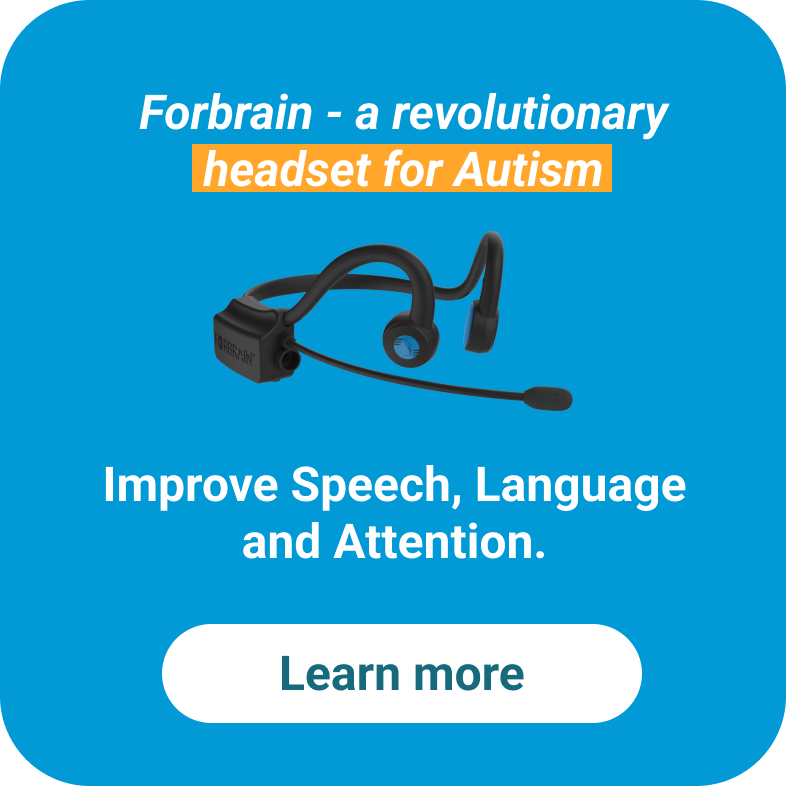How Does Autism Affect Learning?
 Amy Yacoub
Amy Yacoub Speech-Language Pathologist
September 04, 2023

6 Ways Autism Affects Learning | Learning Strategies | The Role of Parents and Educators | Using Forbrain
Autism is a complex neurodevelopmental disorder that can result in profound effects in the area of learning due to key factors such as sensory processing differences, cognitive differences, language and communication challenges.
60-70% of people who have Autism will also have a learning disability. Research by the Center for Disease Control and Prevention (CDC) shows a strong overlap between Autism and Learning Disabilities.
Reading disabilities have been found to be the most common comorbid learning disability that Autistic children have. In fact, growing research suggests that children with Autism are considered at risk for reading and learning difficulties.
A thorough understanding of the factors involved is critical to help a child succeed academically. How does Autism impact learning? Let’s explore the many areas that affect learning abilities in children with Autism.
6 Ways Autism Affects Learning
Here are the top 6 ways that Autism affects the learning process. We’ll discuss some specific scenarios for examples of these unique differences.
Sensory Processing Differences
According to research, sensory processing has a strong impact on school performance in children with Autism Spectrum Disorder. Sensory processing refers to the way that an individual perceives and responds to sensory stimuli around them (for example, visual input or sounds).
How does Autism affect students in the classroom? Autistic children can show the following differences in sensory processing, which can result in difficulties interacting within a classroom:
- Hypersensitivity: heightened sensitivity to sensory stimuli, resulting in difficulty concentrating on academic activities. In a classroom, a child can become easily distracted by subtle sounds like the flickering of a light.
- Hyposensitivity: reduced sensitivity/awareness to sensory input (i.e., sounds, touch, or body position (proprioception). The child might not notice sounds like their teacher calling their name, or can have handwriting difficulties (they require more significant touch to process sensory input).
- Sensory Integration Difficulties: how the brain processes and organizes various types of sensory input from different sources. In a learning environment, a child could become overwhelmed by several types of input, such as the sound of a teacher giving instructions, touch/movement of their body as they write, and looking at a room full of toys and other children. The child might shut down from participating in academic activities.
- Sensory Seeking: children with hyposensitivity seek out sensory input to compensate for being less aware of stimuli. This can have a potential impact on learning with Autism, as the child might have trouble sitting still in a chair and instead seek movement. That can impact their attention to academic instruction at school.
Executive Functioning Deficits
Executive functioning refers to the set of cognitive skills that are used to complete tasks. Children with Autism can show deficits in this area, which can significantly impact their learning behaviors in ways such as:
- Difficulty with Planning & Organization: difficulty initiating a task. The child might struggle with planning how to break down a larger task into smaller, more manageable tasks (like when solving a mathematical word problem).
- Impaired Working Memory: trouble retaining a small amount of information so that it’s readily accessible. A child with Autism might have trouble remembering and applying certain concepts that they’ve been taught, or following multistep directions.
- Reduced Attention: Children with Autism can have difficulty ignoring distractions, shifting their attention between different tasks, and maintaining their attention to certain activities.
Language and Communication Challenges
Children with Autism typically have delays in language development, which can result in challenges during the learning process. Language skills are known to strongly predict later academic performance in school-aged children.
- Delayed expressive language skills: This can cause a child to have difficulty communicating their wants, needs, and thoughts within a classroom. Having a delayed vocabulary can lead to trouble expressing age-appropriate concepts, like naming shapes, colors, or letters.
- Delayed Receptive language skills (comprehension): The child might have trouble following directions, comprehending information in stories, and understanding academic concepts.
- Difficulty with the Social Use of Language: This is one of the defining characteristics of Autism, which can impact a child’s learning experience. During group academic tasks, a child with Autism can have difficulty participating due to various factors. He or she may have trouble initiating or sustaining a conversation with peers. The child could also have difficulty understanding verbal or nonverbal social cues. For example, interpreting body language and subtle verbal cues accurately to know when someone is disinterested in what they are talking about. Due to their difficulties with social language, the child might feel isolated and have difficulty interacting with peers while at school.
Cognitive Processing Differences
Many children with Autism process information differently, with many having enhanced visual processing skills. The child may be able to easily memorize and recreate a pattern they see or quickly complete a puzzle.
This can be a strength when completing some tasks. However, it can lead to challenges in processing information when it is presented verbally or written (like verbally presented directions or teaching of concepts).
Challenges understanding abstract concepts can lead to an Autistic child having trouble with the following:
- Understanding Figurative Language: difficulty understanding figurative language, analogies, and metaphors.
- Generalization: The ability to transfer knowledge or skills learned in one context to other environments can be difficult for children with Autism. The child may learn skills like following multi step directions during a Speech Therapy session but not use these skills when they are in a classroom.
Learning Style Preferences
Children with Autism tend to have strengths in visual learning. When information is only presented auditorily, an Autistic child may not learn that academic concept as easily as if it were paired with a visual, like a diagram or picture.
Some Autistic children have a preference for structured environments, and thrive off of having predictable routines. Challenges may arise when routines are changed within a classroom. A child may have difficulty adapting to a newly presented task, like doing a group science experiment instead of an individual project at their desk.
Restrictive and Repetitive Behaviors
Restrictive and Repetitive Behaviors (RRBs) are considered hallmark symptoms of Autism. This includes focused interests on a certain topic or object and stimming behaviors (ex: hand flapping, lining up toys).
These behaviors can distract a child with Autism from attending to and learning the concepts being presented within an academic setting. Intense interests can interfere with the child’s ability to adapt to learning new or unfamiliar material.
Learning Strategies for Students with Autism
Parents and teachers can incorporate several specific strategies like these to help individuals with Autism learn concepts more effectively:
Incorporate Visual Supports
Visual aids like visual schedules, visual representations of time (like visual timers), and picture cues can help an Autistic child understand information and following directions.
Example: Hang up a schedule that shows pictures of what academic activities the child will be participating in that day. Review it with the child in the morning, and refer to it throughout the day.
Create a Structured Environment
Establish consistent routines and provide clear expectations.
Example: Follow a classroom schedule that shows different learning activities throughout the day.
Incorporate Social Skills Training
Teach a child specific social skills, like how to start a conversation, by role-playing, using video modeling (showing videos of children using the skill), or social stories.
Example: to teach how to ask someone a question, you and your child can pretend with toy figures as you demonstrate this skill.
Use Individualized Instruction
Recognize the child’s specific needs and strengths, and use these to incorporate specific accommodations for him or her.
Example: if the child is hypersensitive to sensory input, have a quiet environment available for him or her to complete their learning tasks.
Allow Sensory Breaks
Consider a child’s sensory needs and create appropriate ways for him or her to fulfill them.
Example: if a child is hyposensitive, deep pressure exercises like hugs or crashing into a beanbag might help the child later concentrate on learning tasks.
Provide Reinforcements
Provide the child with reinforcements like praise/high fives or preferred activities to reward him or her for completing a desired task, like tracing letters or following directions.
The Role of Parents and Educators in the Learning Process
Parents and teachers play a critical role in educating Autistic students. They can recognize a child’s unique strengths and areas of need to create an optimal learning environment.
Parents and educators should collaborate because they each offer unique insight and expertise that can help others understand the child’s needs and abilities.
Parents and educators can support and engage with the child by incorporating the child’s interests into learning activities. For example, if a child has a special interest in a video game, consider working on their comprehension by reading facts about the game and then asking them questions.
Utilize the child’s unique strengths to help them learn new material. If the child is hyposensitive, and craves movement, an extracurricular activity like Karate or soccer can help the child work on social skills, following directions, and other language skills.
FAQs
Here are some frequently asked questions about how Autism affects learning.
Is Autism Considered A Learning Disability?
No, Autism is a neurodevelopmental disorder. Studies suggest 60-70% of individuals with Autism also have a learning disability.
How Does Autism Affect Academic Performance?
Children with Autism can have difficulty focusing, retaining information, understanding abstract concepts, and social interaction difficulties within a classroom.
Can Autism Affect Comprehension?
Yes, children with Autism often have delays in comprehension, including difficulty understanding age-appropriate concepts and academic material.
Does Autism Affect Concentration?
Yes. Children with Autism may have trouble staying focused on a task or can become easily distracted by sensory stimuli around them.
Does Autism Affect Memory?
Yes, some children with Autism have deficits in working (short term) memory, causing difficulties retaining and recalling information.
Using Forbrain to Help with Autism Spectrum Disorder
Parents and Educators can consider using tools to help improve the learning process for children with Autism.
Forbrain is an auditory stimulation headset designed to help a child to hear and process the sounds that they produce, louder and better. It is an altered auditory feedback device that is designed to improve attention and focus, enhance speech and language skills, and boost confidence in communication. When wearing the easy and intuitive device, Forbrain is designed to modulate a child’s voice so it sounds clearer and stimulates the brain to retrain its abilities.
Final Words
Autism is a complex neurodevelopmental disorder that affects a child’s learning in several ways. Differences in sensory processing, executive functioning, language skills, and more can all have an impact on how a child performs in an academic setting.
Parents, educators, and healthcare professionals can use individualized strategies to help children with autism spectrum disorder learn information more easily.
References
Butera, C., et.al. (2020). Impact of Sensory Processing on School Performance Outcomes in High Functioning Individuals with Autism Spectrum Disorder. DOI: https://doi.org/10.1111/mbe.12242
Kastner, J. W., et.al. (2001). Relationship between language skills and academic achievement in first grade. DOI: https://doi.org/10.2466/pms.2001.92.2.381
Ravizza, S. M., et.al. (2013). Restricted and repetitive behaviors in autism spectrum disorders: the relationship of attention and motor deficits. DOI: https://doi.org/10.1017/S0954579413000163
Vale, A. P., et. al. (2022). Word reading skills in autism spectrum disorder: A systematic review. DOI: https://doi.org/10.3389/fpsyg.2022.930275





